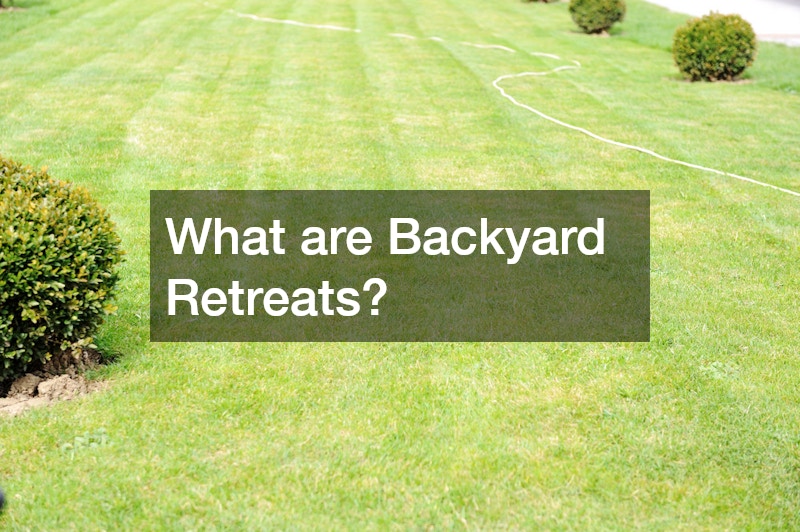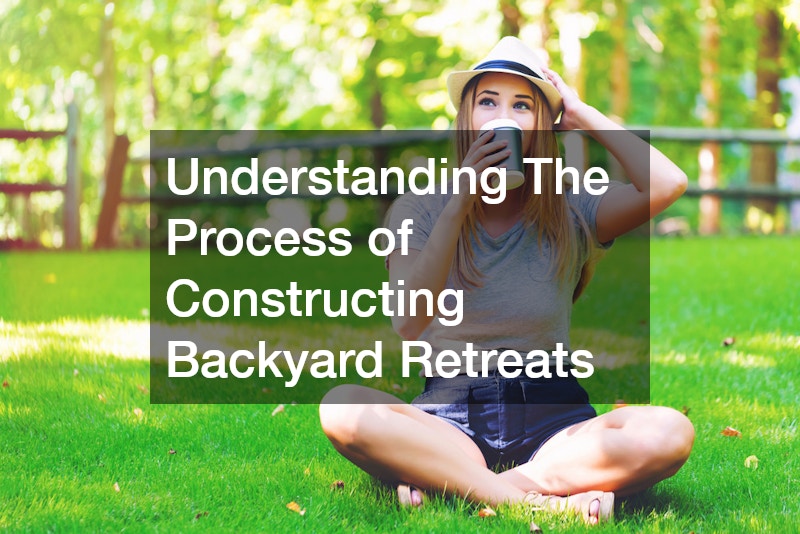Backyard retreats are more than a passing home design trend—they’re a lifestyle enhancement. These personalized spaces offer homeowners a serene escape, right outside their door. From the initial concept to the final touches, constructing a backyard retreat involves a thoughtful process that balances beauty, function, and individuality. This article delves into what backyard retreats are, how to plan them, what to include, and how to maintain them for long-term enjoyment. Along the way, we’ll explore the essential roles played by professional services such as excavating contractors, well service providers, and even water restoration companies in creating a truly resilient and comfortable outdoor space.
What are Backyard Retreats?

Definition and Purpose
A backyard retreat is a purposefully designed outdoor living space created to provide comfort, relaxation, and an immersive natural experience. Unlike traditional yards that are primarily open spaces, backyard retreats are curated environments—often with zones for lounging, entertaining, gardening, or meditating. Their core purpose is to offer a peaceful sanctuary that complements indoor living while connecting people to nature.
Popular Designs and Styles
Design options for backyard retreats are as diverse as the people creating them. Some homeowners opt for modern Zen-inspired spaces with minimalist landscaping and clean lines, while others favor rustic charm with stone pathways, pergolas, and lush plantings. Incorporating natural stone into walkways, retaining walls, or patios is a popular way to add texture and durability while maintaining an organic feel. Materials sourced from local masonry companies and metal suppliers help achieve these styles with structural reliability and aesthetic appeal.
Benefits of Having a Backyard Retreat
A well-designed backyard retreat significantly enhances quality of life. It provides a private space for relaxation and stress relief, increases outdoor living functionality, and boosts property value. Retreats can also support physical and mental health by promoting time spent outdoors. Whether hosting social gatherings or practicing yoga at sunrise, the retreat becomes a versatile venue for various activities. With the right design, it can also reduce dependency on indoor utilities, especially when supported by well service for irrigation or water features.
Common Misconceptions
Some believe backyard retreats are costly luxuries or require vast spaces to be effective. In reality, retreats can be tailored to virtually any budget or yard size. Another misconception is that they demand constant upkeep. While maintenance is important, thoughtful design using low-maintenance materials and native plants can reduce the burden significantly. Professional services, such as hiring a pest control company to manage insects or engaging water restoration companies to prevent long-term damage from leaks, help maintain the retreat’s integrity over time.
How They Differ from Regular Backyards
Unlike conventional backyards that may simply serve as lawns or play areas, retreats are purposeful spaces designed for tranquility and enjoyment. They often include functional elements like seating, shading, and lighting, with a greater emphasis on atmosphere, aesthetics, and sensory experience. A backyard retreat is an extension of the home, intended to be used and cherished year-round. In many ways, it transforms underutilized space into a destination.
How to Plan Your Ideal Backyard Retreat?
Setting Clear Objectives
Before breaking ground, it’s vital to define what you want your retreat to accomplish. Whether you’re seeking a peaceful reading nook, a space to entertain guests, or a family-friendly haven, clear objectives guide the design and material selection. Understanding the retreat’s intended use ensures a focused and cohesive result.
Budget Considerations
Budgeting sets realistic expectations for the scope and quality of your project. Consider costs not only for building materials and furniture but also for services like excavating services to level or reshape your yard. If water elements are part of the design, account for professional well service or plumbing costs. It’s also wise to factor in future maintenance, including routine visits from a pest control company to preserve the space’s comfort.
Choosing the Right Location
The success of your retreat hinges on location. Ideal placement considers sunlight, wind patterns, drainage, and proximity to the home. In sloped or uneven yards, bringing in an excavating contractor to level the land or build terraced landscaping can be a critical first step. These professionals ensure a stable foundation and proper water flow, which contributes to the retreat’s long-term durability.
Integrating Personal Preferences
A backyard retreat should reflect your lifestyle and personal aesthetic. Whether you prefer minimalist lines or natural textures, your vision will inform the materials and layout. If you’re drawn to rustic or rural designs, consider working with a pole barn company to incorporate sheltered outdoor areas that mimic classic barn structures. These additions not only elevate the visual appeal but also provide practical, year-round functionality.
Utilizing Professional Design Services
Engaging landscape designers or outdoor architects can help you achieve a balanced and cohesive retreat. These professionals often coordinate with various vendors, including metal suppliers for structural frames, masonry companies for custom stonework, and dumpster rental services to manage construction debris efficiently. Their expertise ensures that all elements of your retreat come together in a way that is both functional and aesthetically pleasing.
What Essential Features Should You Include?

Seating Arrangements
Seating is foundational to any backyard retreat. Comfortable, durable furnishings encourage regular use of the space. Consider built-in benches made from natural stone or wooden decks with metal-framed furniture for a stylish yet sturdy setup. Seating should be arranged to promote conversation, relaxation, and unobstructed views of focal points like water features or gardens.
Water Features
Water brings movement, sound, and serenity to an outdoor space. Popular features include fountains, waterfalls, and ponds. Installation often requires coordination with well service providers or plumbing experts to ensure proper flow and water quality. Including natural stone around these features creates a seamless blend with the surrounding landscape and enhances their tranquil effect.
Greenery and Landscaping
Lush greenery transforms any outdoor area into a refreshing oasis. Native plants are ideal, as they require less water and maintenance. Trees, shrubs, and perennials add privacy, color, and texture throughout the seasons. Collaborating with a landscaping team and masonry companies can help integrate flower beds, retaining walls, or even raised vegetable gardens into the layout.
Outdoor Lighting
Strategic lighting extends the usability of your retreat into the evening hours. Options range from solar path lights and string lights to built-in LED fixtures. Well-placed lights can highlight architectural features, ensure safety along pathways, and create ambiance. When powered efficiently, lighting also supports sustainability without sacrificing beauty.
Recreational Additions
For families or social butterflies, incorporating recreational elements enhances the space’s functionality. This might include a fire pit, outdoor kitchen, hot tub, or games area. Structural enhancements from metal suppliers or custom work from a pole barn company can help support these features, making them durable and weather-resistant.
How to Choose the Right Materials?
Sustainable Options
Environmentally friendly materials are increasingly important in outdoor design. Recycled metal, reclaimed wood, and locally sourced natural stone reduce your project’s environmental impact. Many homeowners work with eco-conscious masonry companies and metal suppliers who prioritize sustainable sourcing and minimal waste practices.
Durability and Maintenance
Choosing long-lasting materials saves money and reduces maintenance over time. Stone, composite decking, and powder-coated metals are excellent choices for weather-exposed surfaces. Regular upkeep, including seasonal inspections and help from pest control companies, keeps these materials looking and performing their best.
Weather Resistance
Materials must withstand regional climate challenges. In colder areas, freeze-resistant natural stone and sealed masonry prevent cracking. In humid climates, rust-resistant metals and mildew-proof fabrics are essential. Consulting with a knowledgeable excavating contractor or design expert can ensure all materials are suited to your environment.
Aesthetic Appeal
Visual harmony is key to a retreat’s impact. Matching textures, colors, and finishes creates a cohesive look. Earthy tones from natural stone, warm wood elements, and sleek metal accents offer a timeless palette that works well in any setting.
Local Availability and Cost
Using locally available materials reduces shipping costs and supports regional businesses. Metal suppliers and masonry companies within your area may also offer more competitive pricing and personalized service. Dumpster rentals from local providers also streamline construction waste disposal, keeping the project efficient and clean.
What is the Role of Landscaping in Backyard Retreats?
Enhancing Aesthetic Value
Landscaping ties together the various elements of a backyard retreat. From lush lawns to ornamental borders, thoughtful design creates an inviting atmosphere. Using natural materials and native plantings helps the space feel integrated with the surrounding environment.
Creating Privacy
Plants, trees, and hedges play a vital role in screening off the retreat from neighboring views. Coupled with fencing or pergolas constructed by a pole barn company or contractor, these elements help create an intimate and protected space.
Promoting Environmental Benefits
Landscaped retreats contribute to soil health, support local wildlife, and aid in stormwater management. Proper planning, including advice from excavating services or well service experts, ensures your landscaping supports both aesthetics and sustainability.
Utilizing Native Plants
Native plants are adapted to local climates and require less water, fertilizer, and care. These selections are also less prone to pest infestations, minimizing the need for regular visits from a pest control company and supporting an environmentally conscious design.
Accentuating Retreat Features
Landscaping isn’t just filler—it can be used to highlight key elements like seating zones, water features, or entryways. Natural stone borders, flower-lined paths, and tree canopies all direct the eye and create visual structure throughout the space.
How to Incorporate Water Features?
Types of Water Features
Backyard retreats often include fountains, ponds, reflecting pools, or even small streams. These features can be both decorative and functional, enhancing tranquility and aiding in temperature regulation.
Installation Processes
Installing water features requires careful planning. You’ll need to consult professionals, such as water restoration companies for waterproofing or drainage issues, and well service experts to ensure reliable water access. Proper excavation is also key, which makes hiring an experienced excavating contractor essential.
Maintenance and Care
To keep water features clean and operational, regular maintenance is needed. This includes checking pumps, controlling algae, and managing debris. Companies that specialize in water restoration often provide services that overlap with these maintenance needs.
Safety Considerations
For families with children or pets, safety is paramount. Secure edges, non-slip surfaces, and appropriate barriers reduce risks. Integrating lighting and motion sensors also helps prevent accidents.
Maximizing Relaxation Potential
Water’s sensory appeal lies in its sound and motion. Pairing water features with surrounding natural stone, soft lighting, and shaded seating maximizes their soothing potential and makes them central to the retreat experience.
How to Address Privacy Concerns?

Designing for Privacy
Layout and structure go a long way in creating a secluded environment. Proper planning ensures sitting areas face inward, away from streets or neighbor views.
Screening Solutions
Trellises, privacy screens, and layered plantings are excellent ways to block sightlines while maintaining beauty. Work with a masonry or pole barn company to incorporate structural solutions that are both decorative and functional.
Fencing Options
Wooden, vinyl, or metal fencing offers varying degrees of privacy and durability. Local metal suppliers often carry options tailored for outdoor environments and can assist in matching styles to the retreat’s aesthetic.
Utilizing Natural Barriers
Trees and shrubs provide organic screening. Dense evergreens or tall grasses grow into natural walls that insulate sound and block views year-round.
Balancing Openness with Seclusion
A successful retreat balances open, airy design with intimate nooks. Mixing hard structures with soft landscape elements gives the space dimension while preserving privacy.
How to Ensure Year-Round Usability?
Weather-Resistant Furniture
Choosing outdoor furniture built to endure seasonal changes ensures continued use. Materials like treated wood, metal, and all-weather fabric prolong the furniture’s life and comfort.
Seasonal Adjustments
Incorporate removable shade sails, fire features, or temporary walls to adjust for changing weather. These flexible solutions allow the retreat to evolve with the seasons.
Heating Solutions for Cold Weather
Patio heaters, fire pits, and built-in fireplaces make retreats cozy in cooler months. These can be custom-designed using masonry services to match the overall aesthetic.
Shading and Cooling for Hot Weather
Pergolas, umbrellas, and mature trees offer natural and structural shading. Pole barn-style covers also add permanent protection, extending usability during hot summers.
Adaptable Design Elements
Modular furniture, rolling planters, and multi-purpose zones ensure the retreat can adapt to changing needs and family dynamics over time.
What Common Mistakes to Avoid?
Overlooking Budget
A detailed budget should account for construction, furnishing, utilities, and services like dumpster rental and pest control. Overextending financially often leads to delays or unfinished projects.
Ignoring Scale and Proportion
Furniture and features must fit the space appropriately. Oversized structures can overwhelm a small yard, while too-small elements can feel lost in a larger area.
Failing to Plan for Future Updates
Leave room for future upgrades, such as new lighting, technology, or additional features. This future-proofing avoids expensive rework down the line.
Neglecting Neighborhood Aesthetics
Your retreat should harmonize with surrounding homes and landscapes. Materials from local masonry companies and colors that reflect the environment help maintain visual cohesion.
Underestimating Maintenance Needs
Every feature, from greenery to water installations, requires upkeep. Establish routines and hire professionals, such as a pest control company or water restoration crew, to handle specialized tasks.
How to Maintain and Update Your Backyard Retreat?

Seasonal Maintenance Tips
Prepare for each season with tasks like pruning, mulching, and winterizing water systems. Excavating services may be needed to correct drainage issues as the landscape settles over time.
Regular Cleaning Routines
Consistent cleaning of patios, furniture, and features keeps the space welcoming. This may involve pressure washing stone surfaces or clearing debris from water elements.
Updating Features and Decor
Refreshing outdoor cushions, lighting, or plantings each year keeps the retreat feeling new. Metal suppliers and masonry companies often offer seasonal design updates to help homeowners stay current.
Sustainable Practices
Composting, using rainwater, and native plantings all contribute to a greener retreat. Incorporating sustainable materials and methods protects the environment and lowers long-term costs.
Planning for Long-Term Use
Design with durability in mind. Partnering with reputable contractors—whether it’s a pole barn company or a trusted excavating contractor—ensures that foundational elements withstand the test of time.
Closing Thoughts
Creating a backyard retreat is a multifaceted process that involves careful planning, design, and maintenance. By understanding the critical components—from site preparation and material selection to professional services like pest control, water restoration, and excavation—you can transform any outdoor space into a personal paradise. With the right vision and support, your backyard becomes more than just a space—it becomes your sanctuary.
